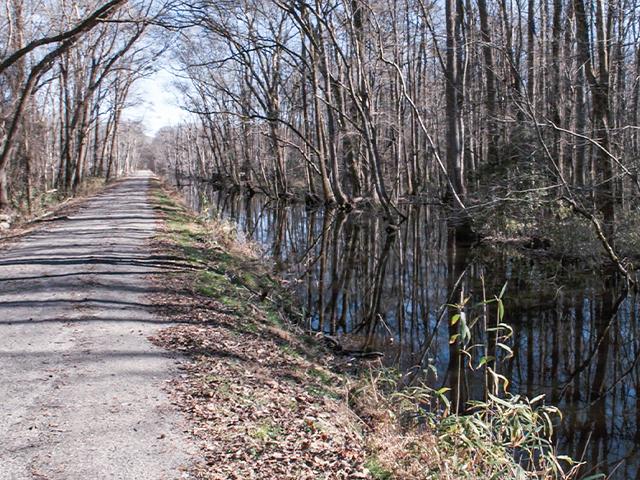
The Great Dismal Swamp once covered more than a million acres between northeastern North Carolina and southeastern Virginia.
Between 1620 and the time of the Civil War, the swamp served as a thriving refuge for runaway slaves who chose to build their lives in freedom no matter the conditions.
“You have venomous snakes, biting insects and flies, a thick cover of greenbrier,” Chris Lowie, Manager of the Great Dismal Swamp National Wildlife Refuge, told CBN News. “A great place as a refuge for wildlife but not as much a great place for refuge for people.”
As many as 50,000 runaway slaves called maroons, an indigenous term, settled in the swamp on small rises of land known as mesic islands.
“The amazing part about the escaped slaves living here in the swamp is that the conditions living in here were better for them than being enslaved,” explained Lowie. “And that is a difficult concept to understand today.”
The escaped slaves established hidden communities in the heavily treed wetlands, building cabins and possibly farming small plots of land.
Researchers believe the former slaves fed their families by hunting deer, wild turkeys, and other game, skills they may have learned from Native Americans who also sought shelter here.
The runaways went to great lengths to keep their settlements secret, due to fear of being captured by slave owners.
Dr. Dan Sayers, an archeologist at American University studied the maroon islands for more than ten years.
“What I’m finding out there in the middle of the swamp is the big ‘ol cabin footprints, a fire pit and all this stuff that shows that this was really active landscape, and most, not to say all, most of the material or artifacts is stone,” Sayers said in an interview with CBN News. “And equally abundant is burnt sand and clay.”
Sayers realized he was onto a significant discovery explained other artifacts found at the site.
“Little pieces of clear glass, a couple of white plats of tobacco pipe fragments, some iron or metals, fragments or little pieces, a smattering of nails, some led shot, couple gun flints chips. It was enough stuff, artifacts, I was able to definitely feel and know that this was of this historic period.”
As a direct descendant of a slave who helped build the Great Dismal Swamp, Eric Sheppard of Newport News, Virginia, shares a personal connection to its history.
“The story of the enslaved people that escaped the plantations and went and lived in the swamp was really first introduced to me in the slave narrative of my ancestor Moses Grandy,” Sheppard said. “He was employed as a boatman and a waterman.”
Grandy traveled the swamp’s canal and learned to navigate boats as logging operations and trade expanded at the site. He and other slaves dug the canal and several ditches by hand.
“As the swamp is today, yes slave labor, those people have a permanent mark on the swamp as it is today,” Lowie said.
After arranging to buy his freedom, Grandy dictated his story, sharing about life as a slave and working in the swamp in his narrative called, Narrative of the Life of Moses Grandy, Late a Slave in the United States of America. He was sure to not mention his interactions with escaped slaves living deep in the swamp.
“He had to still be mindful of when he shared his story, you had to protect people,” said Sheppard. “It was a certain amount of secrecy.”
While many runaway slaves made the swamp their home, others saw it as just a stop on their journey north, as part of the Underground Railroad.
“Dismal Swamp was a refuge,” said Sheppard. “It was a haven for the Underground Railroad activity. Could you imagine down in Louisiana if you get to the Dismal Swamp, you’re almost home free.”
In 2004 the refuge was designated an important landmark on the National Underground Railroad Network to Freedom.
It was the freedom maroons in the swamp preferred to living in captivity.
“It tells us just how horrible slavery was and really let’s not forget the racism and the white supremacy part,” said Sayers.
Sheppard believes those who made their lives in the swamp were from the Zambia and Angola regions of Africa and were able to survive because of similar terrain.
“All we hear about 1619 was a slave ship that arrived in Hampton at Port Comfort from Angola,” he said.
As a member of the Strategic Tourism Partnership between the Great Dismal Swamp National Wildlife Refuge and the Brotese Royal Establishment in Western Province, Zambia, Sheppard travels to Africa often.
During trips that have become known as “homecomings,” he has learned more about his ancestors who were taken captive from the region and brought to America as slaves.
“The traditional leaders told me that they have oral history of the Arab slave traders coming through that land and taking people right into Angola. And so, from Angola, to the slave ship to Virginia. And in that part of Angola, very swampy land. Very humid, very hot, venomous snakes.
“They knew how to go to higher ground, build their homes,” added Sheppard.
“When some of them {of} course got here and they said the swamp, and what we consider as a place you didn’t want to go to, they saw freedom. ‘Oh, we can work with this.'”
Meanwhile, when slavery ended in 1863, maroons living in the swap were free to leave. Many moved to the surrounding communities of Chesapeake, Suffolk, and Norfolk, Virginia.
It is a time in American history many compare to the biblical account of Israel’s deliverance from bondage.
“How did God deliver them out? People can’t explain it – it’s only one explanation – the same God yesterday, today, and forever,” said Sheppard.
The remainder of this article is available in its entirety at CBN